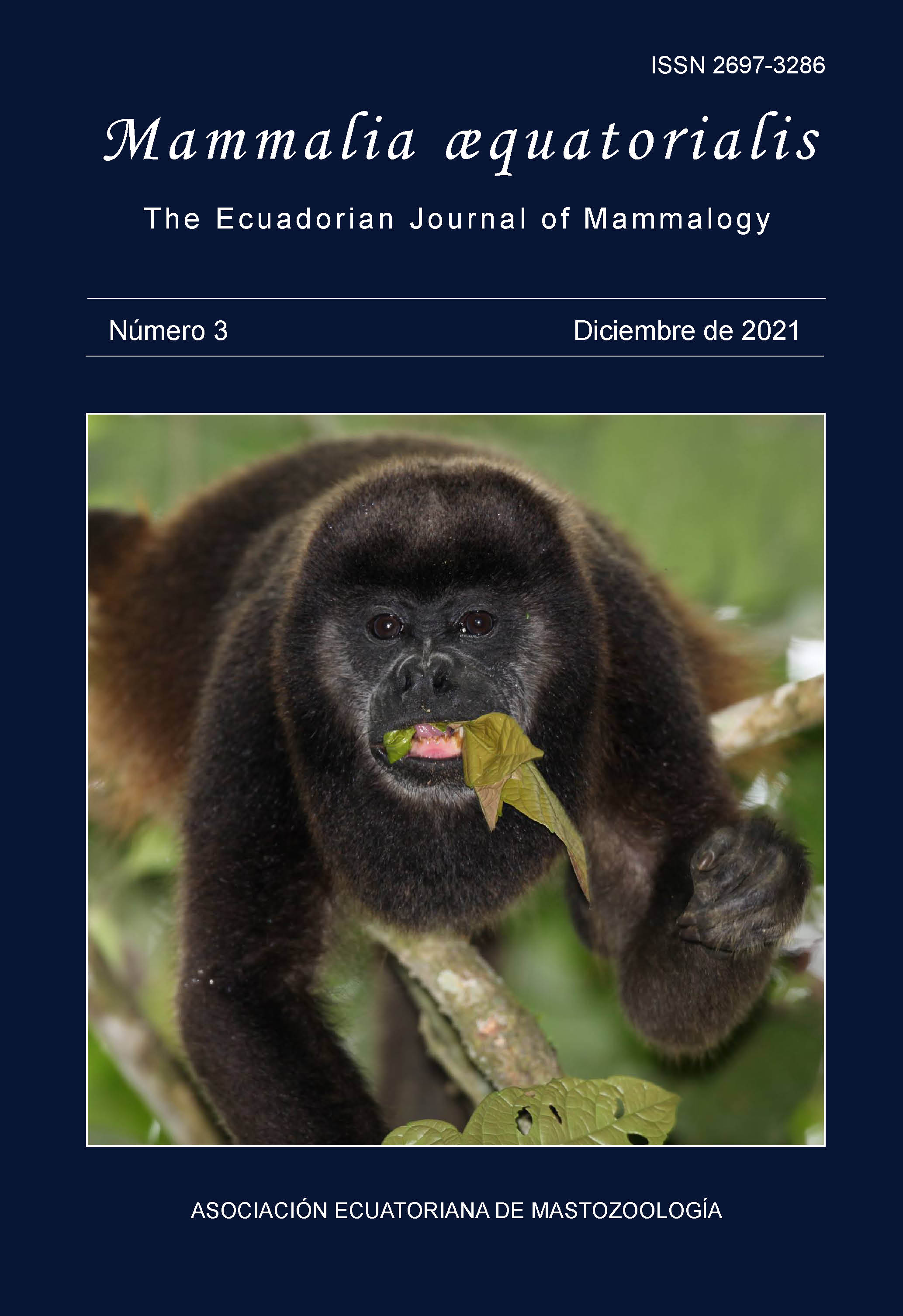Tripanosomas que infectan mamíferos: estado del arte en Ecuador y recomendaciones para su estudio
DOI:
https://doi.org/10.59763/mam.aeq.v3i.12Palabras clave:
animales domésticos, enfermedad de Chagas, filogenia, gen 18S rRNA, pequeños mamíferos, Tripanosoma, Rattus, Didelphis, Simosciurus, CostaResumen
Trypanosoma brucei y T. cruzi son parásitos de interés médico por las enfermedades que causan en humanos y en mamíferos domésticos. Sin embargo, estas y muchas otras especies de tripanosomas infectan también a mamíferos silvestres, e investigarlas es importante porque permiten: 1) entender el solapamiento de los ciclos domésticos y silvestres de transmisión; 2) comprender los orígenes evolutivos de las especies que infectan humanos; y 3) analizar relaciones ecológicas y evolutivas entre parásitos, hospederos y su ambiente. En este artículo reviso los avances en el estudio de tripanosomas que infectan mamíferos no humanos en Ecuador y discuto tendencias para su estudio futuro en el país. Es notorio el número relativamente bajo de estudios publicados (n = 18), enfocados mayoritariamente en Trypanosoma cruzi y realizados con material colectado principalmente en las provincias de Guayas, Loja y Manabí. Por lo tanto, es evidente que falta mucho por estudiar en el Ecuador; en especial, recomiendo estudiar tripanosomas de mamíferos que han sido poco representados en estudios anteriores, tales como carnívoros, murciélagos y primates. Finalmente, sugiero que los estudios futuros vayan más allá de reportar prevalencias y nuevos hospederos, y se dirijan hacia estudios más conceptuales, como poner a prueba hipótesis ecológicas y evolutivas.
Descargas
Literatura citada
Álvarez, J. (1947). Información epidemiológica de la enfermedad de Chagas en Guayaquil. Revista Ecuatoriana de Higiene y Medicina Tropical, 8–9(1–4), 1–50.
Carrillo-Bilbao, G., Martin-Solano, S., y Saegerman, C. (2021). Zoonotic Blood-Borne pathogens in non-human primates in the Neotropical Region: A Systematic Review. Pathogens, 10(8), 1009. https://doi.org/10.3390/pathogens10081009
Chávez‐Larrea, M. A., Medina‐Pozo, M. L., Cholota‐Iza, C. E., Jumbo‐Moreira, J. R., Saegerman, C., Proaño‐Pérez, F., Ron-Román, J., y Reyna‐Bello, A. (2021). First report and molecular identification of Trypanosoma (Duttonella) vivax outbreak in cattle population from Ecuador. Transboundary and Emerging Diseases, 68(4), 2422–2428. https://doi.org/10.1111/tbed.13906
Coello-Peralta, R. D., Cabrera Solórzano, N. C., Ruiz Peñafiel, K. A., Salazar Mazamba, M. D. L., y Reyes Echeverría, E. O. (2020). First report of sheep naturally infected with Trypanosoma sp. in Ecuador. Ciência Rural, 51(1), E20200223. https://doi.org/10.1590/0103-8478cr20200223
Coello-Peralta, R. D., Cabrera Solórzano, N. C., Salazar Mazamba, M. D. L., Reyes Echeverria, E. O., Andrade Velásquez, L. L., & Pazmiño Gómez, B. J. (2022). Natural infection of Trypanosoma sp. in domestic sheep from Ecuador. Ciência Rural, 52(2). e20210141. https://doi.org/10.1590/0103-8478cr20210141
Cottontail, V. M., Kalko, E. K., Cottontail, I., Wellinghausen, N., Tschapka, M., Perkins, S. L., y Pinto, C. M. (2014). High local diversity of Trypanosoma in a common bat species, and implications for the biogeography and taxonomy of the T. cruzi clade. PLoS One, 9(9), e108603. https://doi.org/10.1371/journal.pone.0108603
Defranc-Issa, M. (1982). Enfermedad de Chagas. Casa de la Cultura Ecuatoriana, Núcleo del Guayas.
Espinoza, L. A. (1953). Algunas consideraciones sobre el comportamiento del Trypanosoma cruzi (Schizotripanum cruzi) en el Didelphis azarae o Didelphis paraguayensis (zarigüeya, zorro común o raposa). Revista Ecuatoriana de Higiene y Medicina Tropical, 10(3–4), 27–34.
Espinoza, L. A. (1955). Epidemiología de la enfermedad de Chagas en la República del Ecuador. Revista Ecuatoriana de Higiene y Medicina Tropical, 12(1), 25–105.
Gebreyes, W. A., Dupouy-Camet, J., Newport, M. J., Oliveira, C. J., Schlesinger, L. S., Saif, Y. M., Kariuki, S., Saif, L. J., Saville, W., Wittum, T., Hoet, A., Quessy, S., Kazwala, R., Tekola, B., Shryock, T., Bisesi, M., Patchanee, P., Boonmar, S., y King, L. J. (2014). The global one health paradigm: Challenges and opportunities for tackling infectious diseases at the human, animal, and environment interface in low-resource settings. PLoS Neglected Tropical Diseases, 8(11), e3257. https://doi.org/10.1371/journal.pntd.0003257
Guhl, F., y Vallejo, G. A. (2003). Trypanosoma (Herpetosoma) rangeli Tejera, 1920: an updated review. Memórias do Instituto Oswaldo Cruz, 98(4), 435–442. https://doi.org/10.1590/S0074-02762003000400001
Halsey, S. (2019). Defuse the dilution effect debate. Nature Ecology & Evolution, 3(2), 145–146. https://doi.org/10.1038/s41559-018-0764-3
Hamilton, P. B., Gibson, W. C., y Stevens, J. R. (2007). Patterns of co-evolution between trypanosomes and their hosts deduced from ribosomal RNA and protein-coding gene phylogenies. Molecular Phylogenetics and Evolution, 44(1), 15–25. https://doi.org/10.1016/j.ympev.2007.03.023
Hoare, C. A. (1972). The trypanosomes of mammals. A zoological monograph. Blackwell Scientific Publications.
Lima, L., Espinosa-Álvarez, O., Pinto, C. M., Cavazzana Jr, M., Pavan, A. C., Carranza, J. C., Lim, B. K., Campaner, M., Takata, C. S. A., Camargo, E. P., Hamilton, P. B., y Teixeira, M. M. (2015). New insights into the evolution of the Trypanosoma cruzi clade provided by a new trypanosome species tightly linked to Neotropical Pteronotus bats and related to an Australian lineage of trypanosomes. Parasites & Vectors, 8(1), 1–18. https://doi.org/10.1186/s13071-015-1255-x
Medina-Naranjo, V. L., Reyna-Bello, A., Tavares-Marques, L. M., Campos, A. M., Ron-Román, J. W., Moyano, J. C., Jarrín-Porras, E. C., Sandoval-Morejón, E. D., y Chávez-Larrea, M. A. (2017). Diagnóstico de los hemotrópicos Anaplasma marginale, Trypanosoma spp. y Babesia spp. mediante las técnicas de ELISAi y PCR en tres fincas ganaderas de la provincia de Pastaza, Ecuador. Revista Científica FCV-LUZ, 27(3), 162–171. https://www.redalyc.org/journal/959/95952010005/html/
Mimori, T., Kawabata, M., Gómez, E., Vera de Coronel, V., de Aroca, M., Flor, T., y Hashiguchi, Y. (1985). A seroepidemiological survey of Chagas’ disease and a search for reservoir hosts in two endemic areas of Ecuador. Japanese Journal of Tropical Medicine and Hygiene, 13(3), 245–250. https://doi.org/10.2149/tmh1973.13.245
Ocaña-Mayorga, S., Llewellyn, M. S., Costales, J. A., Miles, M. A., y Grijalva, M. J. (2010). Sex, subdivision, and domestic dispersal of Trypanosoma cruzi lineage I in southern Ecuador. PLoS Neglected Tropical Diseases, 4(12), e915. https://doi.org/10.1371/journal.pntd.0000915
Ocaña-Mayorga, S., Aguirre-Villacís, F., Pinto, C. M., Vallejo, G. A., y Grijalva, M. J. (2015). Prevalence, genetic characterization, and 18S small subunit ribosomal RNA diversity of Trypanosoma rangeli in triatomine and mammal hosts in endemic areas for Chagas disease in Ecuador. Vector-Borne and Zoonotic Diseases, 15(12), 732–742. https://doi.org/10.1089/vbz.2015.1794
Ocaña-Mayorga, S., Lobos, S. E., Crespo-Pérez, V., Villacís, A. G., Pinto, C. M., y Grijalva, M. J. (2018). Influence of ecological factors on the presence of a triatomine species associated with the arboreal habitat of a host of Trypanosoma cruzi. Parasites & Vectors, 11(567), 1–9. https://doi.org/10.1186/s13071-018-3138-4
Ocaña-Mayorga, S., Bustillos, J. J., Villacís, A. G., Pinto, C. M., Brenière, S. F., y Grijalva, M. J. (2021). Triatomine feeding profiles and Trypanosoma cruzi infection, implications in domestic and sylvatic transmission cycles in Ecuador. Pathogens, 10(1), 42. https://doi.org/10.3390/pathogens10010042
Pinto, C. M., Grijalva, M. J., y Costales, J. A. (2003). Prevalencia de Trypanosoma cruzi en roedores y marsupiales en dos localidades de Manabí, Ecuador. Revista de la Pontificia Universidad Católica del Ecuador, 71, 225–233.
Pinto, C. M., Ocaña-Mayorga, S., Lascano, M. S., y Grijalva, M. J. (2006). Infection by trypanosomes in marsupials and rodents associated with human dwellings in Ecuador. Journal of Parasitology, 92(6), 1251–1255. https://doi.org/10.1645/GE-886R.1
Pinto, C. M., Baxter, B. D., Hanson, J. D., Méndez-Harclerode, F. M., Suchecki, J. R., Grijalva, M. J., Fulhorst, C. F., & Bradley, R. D. (2010). Using museum collections to detect pathogens. Emerging Infectious Diseases, 16(2), 356–357. https://doi.org/10.3201/eid1602.090998
Pinto, C. M., Kalko, E. K., Cottontail, I., Wellinghausen, N., y Cottontail, V. M. (2012). TcBat a bat-exclusive lineage of Trypanosoma cruzi in the Panama Canal Zone, with comments on its classification and the use of the 18S rRNA gene for lineage identification. Infection, Genetics and Evolution, 12(6), 1328–1332. https://doi.org/10.1016/j.meegid.2012.04.013
Pinto, C. M., Ocaña-Mayorga, S., Tapia, E. E., Lobos, S. E., Zurita, A. P., Aguirre-Villacís, F., MacDonald, A., Villacís, A. G., Lima, L., Teixeira, M. M. G., Grijalva, M. J., y Perkins, S. L. (2015). Bats, trypanosomes, and triatomines in Ecuador: new insights into the diversity, transmission, and origins of Trypanosoma cruzi and Chagas disease. PloS One, 10(10), e0139999. https://doi.org/10.1371/journal.pone.0139999
Pinto, C. M., Ojala-Barbour, R., Brito, J., Menchaca, A., Carvalho, A. L., Weksler, M., Amato, G., y Lee Jr, T. E. (2018). Rodents of the eastern and western slopes of the Tropical Andes: phylogenetic and taxonomic insights using DNA barcodes. Therya, 9(1), 15–27. https://doi.org/10.12933/therya-18-430
Randolph, S. E., y Dobson, A. D. (2012). Pangloss revisited: A critique of the dilution effect and the biodiversity-buffers-disease paradigm. Parasitology, 139(7), 847–863. https://doi.org/10.1017/S0031182012000200
Rivadeneira-Barreiro, P. E., de Oca-Jiménez, R. M., Vázquez-Chagoyán, J. C., Martínez-Subiela, S., Morán-Loor, A., Ochoa-García, L., Zambrano-Rodríguez, P. C., Garg, N. J., & Varela-Guerrero, J. A. (2021). Trypanosoma cruzi co-infections with other vector borne diseases are frequent in dogs from the pacific coast of Ecuador. Microbial Pathogenesis, 155, 104884. https://doi.org/10.1016/j.micpath.2021.104884
Ronquist, F. (1997). Phylogenetic approaches in coevolution and biogeography. Zoologica Scripta, 26(4), 313–322. https://doi.org/10.1111/j.1463-6409.1997.tb00421.x
Salzer, J. S., Pinto, C. M., Grippi, D. C., Williams-Newkirk, A. J., Peterhans, J. K., Rwego, I. B., Carroll, D. S., y Gillespie, T. R. (2016). Impact of anthropogenic disturbance on native and invasive trypanosomes of rodents in forested Uganda. EcoHealth, 13(4), 698–707. https://doi.org/10.1007/s10393-016-1160-6
Schmidt, K. A., y Ostfeld, R. S. (2001). Biodiversity and the dilution effect in disease ecology. Ecology, 82(3), 609–619. https://doi.org/10.1890/0012-9658(2001)082[0609:BATDEI]2.0.CO;2
Wells, E. A., Betancourt, A., y Ramirez, L. E. (1977). Serological evidence for the geographical distribution of Trypanosoma vivax in the New World. Transactions of the Royal Society of Tropical Medicine and Hygiene, 71(5), 448–449. https://doi.org/10.1016/0035-9203(77)90055-4
Wyatt, K. B., Campos, P. F., Gilbert, M. T. P., Kolokotronis, S. O., Hynes, W. H., DeSalle, R., Daszak, P., MacPhee, R. D. E, y Greenwood, A. D. (2008). Historical mammal extinction on Christmas Island (Indian Ocean) correlates with introduced infectious disease. PloS One, 3(11), e3602. https://doi.org/10.1371/journal.pone.0003602
Publicado
Cómo citar
Número
Sección
Categorías
Licencia
Derechos de autor 2021 C. Miguel Pinto

Esta obra está bajo una licencia internacional Creative Commons Atribución-NoComercial-CompartirIgual 4.0.
Los autores que publiquen en esta revista aceptan las siguientes condiciones:
- Los autores/as conservan los derechos de autor y ceden a la revista el derecho de la primera publicación, con el trabajo registrado con la licencia de atribución de Creative Commons 4.0, que permite a terceros utilizar lo publicado siempre que mencionen la autoría del trabajo y a la primera publicación en esta revista.
- Los autores/as pueden realizar otros acuerdos contractuales independientes y adicionales para la distribución no exclusiva de la versión del artículo publicado en esta revista (p. ej., incluirlo en un repositorio institucional o publicarlo en un libro) siempre que indiquen claramente que el trabajo se publicó por primera vez en esta revista.
- Se permite y recomienda a los autores/as a compartir su trabajo en línea (por ejemplo: en repositorios institucionales o páginas web personales) antes y durante el proceso de envío del manuscrito, ya que puede conducir a intercambios productivos, a una mayor y más rápida citación del trabajo publicado.










